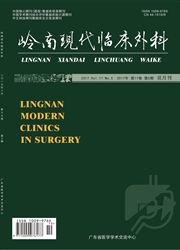

 中文摘要:
中文摘要:
目的观察益气活血通络法结合颈椎前路或后路手术治疗颈椎管狭窄症的临床疗效。方法采用随机对照临床试验设计方法。将60例需手术治疗的颈椎管狭窄症患者以1:1比例随机分成试验组和对照组。所有患者根据影像学表现和临床症状,选择颈椎后路椎管扩大成形术或前路减压植骨融合内固定术,术后均佩戴颈围固定2个月。试验组在手术后即服用益气活血通络法代表方加味补阳还五汤,每天1剂,连服15天。采用日本骨科学会(JOA)17分法分别在手术前和手术后1个月、3个月、6个月随访时评定神经功能,并在手术后6个月时使用Hirabayashi法计算JOA评分改善率。结果两组患者手术前JOA评分比较,差异无统计学意义;手术后1个月、3个月、6个月JOA评分比较,差异均有统计学意义(P〈0.05);手术后6个月JOA评分改善率。差异有统计学意义(P〈0.05)。结论采用颈椎后路椎管扩大成形术或前路减压植骨融合内固定术治疗颈椎管狭窄症,联合应用加味补阳还五汤内服,术后疗效满意。
 英文摘要:
英文摘要:
Objective To observe the clinical effects of combination of supplementing Qi and activating blood circulation and dredging collaterals with surgical treatment on the treatment of cervical spinal stenotic myelopathy. Methods Sixty cases cervical spinal stenotic myelopathy who required surgical treatment were randomly divided into experimental group and control group. All patients were treated with posterior cervical laminoplasty or anterior decompression and fusion with internal fixation, and wore neck fixed for 2 months after surgery. Patients of experiment group was added to treat with supplementing Qi and activating blood circulation and dredging collaterals Jiawei Buyang Huanwu decoction once daily after surgery for 15 days. JOA (Japanese Orthopaedic Association) scores were used to assess nerve function before surgery and l, 3, 6 months follow-up after surgery,and Hirabayashi method was used to calculate the improvement rate of JOA score at 6 months after surgery. Results There was no statistically significant difference in JOA score between experimental group and control group before surgery. The significant differences in JOA score were found between experimental group and control group at 1 month, 3 months, 6 months after surgery (P〈O.05). The improvement rate of JOA score also showed signficant difference between experimental group and control group at 6 months after surgery (P〈0.05). Conclusion Combination of surgical treatment of posterior cervical laminoplasty or anterior decompression and fusion with internal fixation with oral administration of Jiawei Buyang Huanwu decoction on cervical spinal stenotic myelopathy obtains satisfactory postoperative curative effect and is worthy of clinical promotion.
 同期刊论文项目
同期刊论文项目
 同项目期刊论文
同项目期刊论文
 期刊信息
期刊信息
